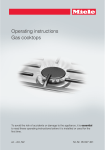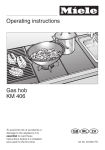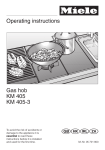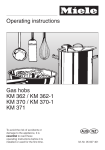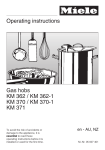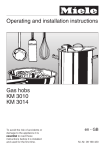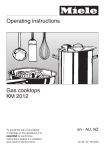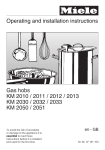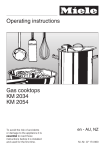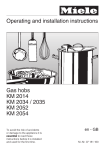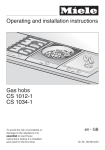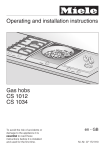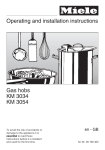Download Miele KM 391 G
Transcript
Operating instructions Gas hobs KM 390 KM 391 To avoid the risk of accidents or damage to the appliance, it is essential to read these operating instructions before it is installed or used for the first time. WO M.-Nr. 05 827 461 Contents Description of the appliance . . . . . . . . . . . . . . . . . . . . . . . . . . . . . . . . . . . . . . . . . 3 Appliance models . . . . . . . . . . . . . . . . . . . . . . . . . . . . . . . . . . . . . . . . . . . . . . . . . . 3 Burner . . . . . . . . . . . . . . . . . . . . . . . . . . . . . . . . . . . . . . . . . . . . . . . . . . . . . . . . . . . 5 Warning and Safety instructions . . . . . . . . . . . . . . . . . . . . . . . . . . . . . . . . . . . . . 6 Caring for the environment . . . . . . . . . . . . . . . . . . . . . . . . . . . . . . . . . . . . . . . . . 12 Before using for the first time . . . . . . . . . . . . . . . . . . . . . . . . . . . . . . . . . . . . . . . 13 General notes . . . . . . . . . . . . . . . . . . . . . . . . . . . . . . . . . . . . . . . . . . . . . . . . . . . . 13 Cleaning and heating up for the first time . . . . . . . . . . . . . . . . . . . . . . . . . . . . . . . 13 Using the gas hob . . . . . . . . . . . . . . . . . . . . . . . . . . . . . . . . . . . . . . . . . . . . . . . . 14 Switching on, controlling, switching off . . . . . . . . . . . . . . . . . . . . . . . . . . . . . . . . . 14 Settings . . . . . . . . . . . . . . . . . . . . . . . . . . . . . . . . . . . . . . . . . . . . . . . . . . . . . . . . . 16 Suitable pans for gas burners . . . . . . . . . . . . . . . . . . . . . . . . . . . . . . . . . . . . . . . . 17 Safety cut-out . . . . . . . . . . . . . . . . . . . . . . . . . . . . . . . . . . . . . . . . . . . . . . . . . . . . . 18 Use during a power cut . . . . . . . . . . . . . . . . . . . . . . . . . . . . . . . . . . . . . . . . . . . . . 18 Cleaning and care . . . . . . . . . . . . . . . . . . . . . . . . . . . . . . . . . . . . . . . . . . . . . . . . 19 General . . . . . . . . . . . . . . . . . . . . . . . . . . . . . . . . . . . . . . . . . . . . . . . . . . . . . . . . . 19 Pan support, Control knobs . . . . . . . . . . . . . . . . . . . . . . . . . . . . . . . . . . . . . . . . . . 19 Hob surface . . . . . . . . . . . . . . . . . . . . . . . . . . . . . . . . . . . . . . . . . . . . . . . . . . . . . . 20 Burners . . . . . . . . . . . . . . . . . . . . . . . . . . . . . . . . . . . . . . . . . . . . . . . . . . . . . . . . . 21 Problem solving guide. . . . . . . . . . . . . . . . . . . . . . . . . . . . . . . . . . . . . . . . . . . . . 24 Gas connection . . . . . . . . . . . . . . . . . . . . . . . . . . . . . . . . . . . . . . . . . . . . . . . . . . 25 Electrical connection . . . . . . . . . . . . . . . . . . . . . . . . . . . . . . . . . . . . . . . . . . . . . . 26 After Sales Service . . . . . . . . . . . . . . . . . . . . . . . . . . . . . . . . . . . . . . . . . . . . . . . 27 Data Plate . . . . . . . . . . . . . . . . . . . . . . . . . . . . . . . . . . . . . . . . . . . . . . . . . . . . . . . 27 2 Description of the appliance Appliance models KM 390 a Wok ring Control knob for cooking zone: b Wok burner i Front right c Auxiliary burner j Rear right d Fast burner k Rear middle e Normal burner l Rear left f Pan support (separate for each burner) m Front left g Cooking zone symbols h Mains connection cable Depending on country of destination, the appliance may be supplied with or without a plug. The plug shown is for illustration only 3 Description of the appliance KM 391 a Wok burner Control knob for cooking zone: b Wok ring i Front right c Auxiliary burner j Rear right d Fast burner k Rear middle e Normal burner l Rear left f Mains connection cable Depending on country of destination, the appliance may be supplied with or without a plug. The plug shown is for illustration only. m Front left g Pan support (separate for each burner) h Cooking zone symbols 4 Description of the appliance Burner Wok burner Auxiliary, normal and fast burner n Burner cap o Burner ring p Burner head q Burner base r Ignitor s Ignition safety device 5 Warning and Safety instructions This appliance complies with all relevant legal safety requirements. Improper use of the appliance can, however, present a risk of both personal injury and material damage. To avoid the risk of accidents and damage to the appliance, read these instructions carefully before using it for the first time. They contain important notes on the installation, safety, operation and care of the appliance. Supervise elderly or infirm when using the appliance. Keep these instructions in a safe place for reference and pass them on to any future user. Building in and connection The connection to the gas supply must be carried out by a suitably qualified and competent person in accordance with local and national safety regulations, e.g. a registered gas fitter. If the appliance is supplied without a plug, or if the plug is removed the appliance must additionally be installed and connected by a suitably qualified and competent electrician in strict accordance with national and local regulations. The manufacturer cannot be held responsible for damage caused by incorrect installation or connection. 6 The electrical safety of this appliance can only be guaranteed when continuity is complete between it and an effective earthing system which complies with local and national safety regulations. It is most important that this basic safety requirement is present and tested regularly, and where there is any doubt, the household wiring system should be inspected by a qualified electrician. The manufacturer cannot be held liable for the consequences of an inadequate earthing system (e.g. electric shock). Ensure that the gas pipe and electrical cable are installed in such a way that they do not touch any parts of the appliance which become hot. This could cause damage. Do not connect the appliance to the mains electricity supply by an extension lead. Extension leads do not guarantee the required safety of the appliance. This equipment is not designed for maritime use or for use in mobile installations such as caravans, aircraft etc. However it may be suitable for such usage subject to a risk assessment of the installation being carried out by a suitably qualified engineer. Warning and Safety instructions Correct usage For safety reasons the appliance must only be operated after it has been built in. This is necessary to ensure that all electric components are shielded. This appliance is for domestic use only, and is not intended for commercial use. Use this appliance for the preparation of food only. Any other usage is at the owner's risk and could be dangerous. The manufacturer cannot be held liable for damage caused by incorrect or improper use of the appliance. Do not use the appliance to heat up the room. The high temperature could cause inflammable objects nearby to catch fire. Using the gas hob can cause heat and moisture to build up in the kitchen. Ensure that the room is well ventilated; open a door or window or provide a mechanical means of ventilation, by installing a cooker hood, for example. Make sure all the components of the gas burners have been correctly assembled before switching on. When using a cooker hood over the gas hob, ensure that any burners in use are always covered with a pan. Otherwise flames could be drawn up by the suction of the cooker hood, parts of which could then be damaged or even set on fire. Pans must be the correct size for the burner they are used on (see "Suitable pans"). A pan which is too small will be unstable on the pan support. If the pan diameter is too large flames can spread out to the sides and damage or burn the worktop, wall claddings or surrounding units and also parts of the hob. The manufacturer cannot be held liable for this type of damage. Do not store any inflammable objects near the gas hob. If the hob is used for very long periods of time additional ventilation of the room may be necessary, e.g. by opening windows or doors, or running the cooker hood on the highest setting. This appliance must not be set up or operated in the open air. 7 Warning and Safety instructions Safety with children The appliance is only intended for use by adults who have read these operating instructions. This appliance is not a toy! To avoid the risk of injury keep children well away and do not let them play with it or use the controls. They will not understand the potential dangers posed by it. They should be supervised whenever you are working in the kitchen. Older children may use the appliance only when its operation has been clearly explained to them, and they are able to use it safely, recognising the dangers of misuse. The appliance gets hot when in use and remains hot for quite a while after being switched off. To safeguard against burning, keep children well away from the appliance at all times. Do not store anything which might arouse a child's interest in storage areas above or next to the appliance. Otherwise they could be tempted into climbing onto the appliance with the risk of burning themselves. 8 Keep all pans out of reach of children. Turn pan handles inwards away from the edge of the hob. Danger of burning or scalding. Special hob guards are available from good retail outlets. Packaging (e.g. cling film, polystyrene) and plastic wrappings must be kept out of the reach of babies and young children. Danger of suffocation. Dispose of all packaging safely as soon as possible. Before disposing of an old appliance, ensure that disconnection from the gas supply is made by a suitably qualified and competent person. Switch off at the mains electricity supply. Cut off and render any plug useless. Cut off the cable directly behind the appliance to prevent misuse. This should be done by a competent person. Ensure that the appliance presents no danger to children while being stored for disposal. Warning and Safety instructions Protecting the appliance from damage Do not use a steam cleaner to clean this appliance. The steam could reach electrical components and cause a short circuit. Pressurised steam could also cause permanent damage to the surface and to other components, for which the manufacturer cannot accept liability. Stainless steel surfaces: Avoid allowing liquids or foods containing salt to spill onto a stainless steel hob or trim. If salty foods or liquids do get on the hob, they should be removed as soon as possible to avoid the risk of corrosion. Replace the pan supports carefully to avoid scratching the surface. Unless the pan manufacturer states that you can do so, you should never use pans with thin bases on this hob and you should never heat up an empty pan. Otherwise the hob could get damaged. In countries where there are areas which may be subject to infestation by cockroaches or other vermin, pay particular attention to keeping the appliance and its surroundings in a clean condition at all times. Any damage which may be caused by cockroaches or other vermin will not be covered by the appliance guarantee. Appliances with a ceramic surface: Do not drop anything on the ceramic surface. Even a light object could cause damage in certain circumstances. 9 Warning and Safety instructions Protection from burning and scalding The surface of the appliance gets hot when in use, and remains hot for quite a while after being switched off. Do not touch it whilst it is still hot. Use heat-resistant pot holders or gloves when handling hot pots and pans. Ensure that they do not come into contact with the flames. Do not use large cloths, tea towels or similar as the ends could touch the flames and catch fire. Take care not to let pot holders or gloves get damp or wet, as this causes heat to transfer through the material quicker with the risk of burning yourself. Do not heat up unopened tins of food on the hob as pressure will build up in the tin and it can explode. This could result in injury or damage. Do not use the hob as a resting place for anything else. If the hob was switched on inadvertently, or if it was still hot the article could begin to melt or catch fire. Do not cover the hob with a cloth, household foils or other similar objects. This could lead to danger of the article catching fire, if the hob were to be switched on inadvertently. 10 Remove splashes of fat and other food debris from the surface as soon as possible. These are a fire hazard. Never leave the appliance unattended when cooking with oil or fat as these are fire hazards if overheated. Very hot oil can catch fire and could even set a cooker hood above on fire. Always heat fat slowly, watching as it heats. If, despite this, oil or fat does catch fire, do not attempt to put out the flames with water. Use a suitable fire blanket, saucepan lid, damp towel or similar to smother the flames. Do not flambé under a cooker hood. The flames could set the cooker hood on fire. Ensure that the flames from the burner do not spread out beyond the base and up the sides of the pan. Do not spray aerosols in the vicinity of this appliance while it is in operation. Warning and Safety instructions With a damaged appliance Further safety notes In the event of damage or a defect, switch off the appliance immediately. Turn off the gas supply tap, and disconnect completely from the electricity supply. Contact the Service department. Ensure that the appliance is disconnected from the electricity supply before any servicing or repair work. When using an electric socket near the appliance, care should be taken that the cable of the electrical appliance does not come into contact with the hot appliance. The insulation on the cable could become damaged, giving rise to an electric shock hazard. Ceramic hobs: Any breakages or cracks in the ceramic surface of the hob are defects and must be treated as such. Repairs to the gas and electrical components of this appliance must only be carried out by a suitably qualified person. Repairs by unauthorised personnel could be dangerous. On no account open the outer casing of the appliance. While the appliance is under guarantee repairs should only be undertaken by a service engineer authorised by the manufacturer. Otherwise the guarantee is invalidated. Always ensure that food is sufficiently cooked or reheated. Many factors will affect the overall cooking time, including the size and amount of food and its temperature. Some foods may contain micro-organisms which are only destroyed by thorough cooking; therefore when cooking or reheating foods such as poultry, it is particularly important that the food is completely cooked through. If in doubt, select a longer cooking or reheating time. Do not use plastic or aluminium foil containers. These melt at high temperatures and could damage the ceramic surface. Fire hazard. Spray canisters, aerosols and other inflammable substances must not be stored in a drawer under the hob. Cutlery inserts must be heat-resistant. If the appliance has not been used for a longer period of time it should be thoroughly cleaned before it is used again. It is also advisable to have the appliance tested for safety. This should be done at regular intervals. The manufacturer cannot be held liable for damage caused by non-compliance with these safety instructions. 11 Caring for the environment Disposal of the packaging material Disposal of your old appliance or machine The transport and protective packing has been selected from materials which are environmentally friendly for disposal and can normally be recycled. Electrical and electronic appliances / machines often contain materials which, if handled or disposed of incorrectly, could be potentially hazardous to human health and to the environment. They are, however, essential for the correct functioning of your appliance or machine. Please do not therefore dispose of your old machine or appliance with your household waste. Packaging (e.g. cling film, polystyrene) and plastic wrappings must be kept out of the reach of babies and young children. Danger of suffocation. Dispose of or recycle all packaging materials as soon as possible. Please dispose of it at your local community waste collection / recycling centre and ensure that it presents no danger to children while being stored for disposal. It should be unplugged or disconnected from the mains electricity supply by a competent person. The plug must be rendered useless and the cable cut off directly behind it to prevent misuse. 12 Before using for the first time General notes A data plate for your appliance is supplied with this documentation. It should be stuck into the space provided at the end of the instruction book. The address of the nearest Service Department is given on the back page. Cleaning and heating up for the first time Before using for the first time clean the hob and all removable parts as follows: ^ The removable parts of the gas burner assembly can be washed in a mild solution of water and washing-up liquid. Wipe dry and reassemble in the correct order (see "Cleaning and care"). ^ Clean the hob with a damp cloth only, and then wipe dry. Do not use washing up liquid to clean the ceramic surface as it can leave a blue sheen which may be difficult to remove. Metal components have a protective coating which may give off a slight smell when the hob is heated up for the first time. The smell and any vapours will dissipate after a short time and do not indicate a faulty connection or appliance. 13 Using the gas hob Switching on, controlling, switching off The control knobs are used to switch on the burner and regulate the strength of the flame. Small, medium and large burners Wok burner The burners can only be switched on by pressing in the appropriate control and turning it anti-clockwise, and switched off by turning the control clockwise. The outer flame ring on the wok burner can only be switched on and off by pressing the control in and turning it the appropriate way. The following can damage components in the appliance: - Trying to switch on a burner without pressing in the control. - Switching off a burner by turning it clockwise. - Switching the outer flame ring on the wok burner on or off without pressing in the control. - Switching on a burner by turning it anti-clockwise. The manufacturer cannot be held liable for this type of damage. To switch on: ^ The control for the burner required must be pressed in and turned anti-clockwise to the large flame symbol to switch on. ^ When the flame ignites, keep the control pressed in for 8-10 seconds, and then let it go. If the flame goes out, repeat the procedure, keeping the control pressed in for a few extra seconds. 14 Using the gas hob Controlling: Switching off: ^ When the flame burns steady after releasing the knob, select a setting between the large and the small flame symbol. The flame gets smaller, when you turn the control knob anti-clockwise and bigger when turning clockwise. You don’t need to press the knob. ^ Turn the knob clockwise until the "ß" position is reached. This stops the flow of gas and the flame goes out. ^ Wok burner: On reaching the resistance briefly press the knob to turn past. Then without pressing it in turn the control to the required setting. ^ Control the flame so that it does not spread out beyond the sides of the pan. As the outer part of the flame is much hotter than the centre, the tips of the flames should stay beneath the pan base. Flame tips which extend beyond the sides of the pan merely warm up the air in the room and can also damage pan handles and increase the danger of burning. 15 Using the gas hob Settings Setting Auxiliary-, nromaland fast burner ß gas supply is turned off * strong flame & - (2x) 16 Wok burner outer ring: inner ring: strong strong outer ring: inner ring: weak strong + - outer ring: inner ring: off strong / weak flame outer ring: inner ring: off weak Using the gas hob Suitable pans for gas burners Small burner 10 Medium burner 12 Large burner 14 Wok burner 14* – Pans with thick bases are preferable as these distribute heat more evenly, and therefore lessen the risk of heat spots occurring which can cause food to stick or burn. With thin bases heat is conducted quickly to the food, however there is a danger of food heating up unevenly and too quickly increasing the risk of burning. Stir the food frequently. Max. diameter at top of pans in cm – Any heat-resistant pans can be used on a gas burner. Small burner 22 Medium burner 22 Large burner 24 – Remember when purchasing new pans that manufacturers usually refer to the diameter at the top of the pan in their documentation. Wok burner 24* Burners Min. pan base diameter in cm * This diameter doesn't apply when using a wok. – You should select pans which are suitable for the burner they are to be used on. In general: use larger diameter pans on the large burner and smaller diameter pans on the small burner. – Wide, shallow pans are preferable to tall, narrow ones. They will heat up faster. – Refer to the chart above and ensure that the pan diameter falls within the minimum and maximum diameters given for the burner you are using. A pan which is too small will be unstable on the pan support. If the pan diameter is too large flames can spread out to the sides and damage or burn the worktop, wall claddings or surrounding units and also parts of the hob. The manufacturer cannot be held liable for this type of damage. – Use a pan lid whenever possible to minimise heat loss. 17 Using the gas hob Safety cut-out Use during a power cut This appliance is fitted with an electric ignition safety device which cuts off the supply of gas to a burner if the flame goes out, for example if food has boiled over, or if there was a sudden draught. If there is an interruption to the electricity supply the gas can be ignited with a match: ^ To use the hob again, turn the knob clockwise until the "ß" position is reached and switch on as normal. The safety cut-out operates independently from the electricity supply. This means that it is still active when the hob is used during a power cut (see "Use during a power cut"). 18 ^ Press in the relevant control knob and turn it anti-clockwise to the large gas symbol. ^ Hold the control pressed in and light the gas at the burner with a match. ^ Keep the control knob pressed in for a further 8-10 seconds and then release it. Cleaning and care General Pan support, Control knobs Clean the appliance regularly, preferably after each use. Allow it to cool sufficiently. Take off the pan supports. Do not use a steam cleaner to clean this appliance. The steam could reach electrical components and cause a short circuit. Pressurised steam could also cause permanent damage to the surface and to other components, for which the manufacturer cannot accept liability. Clean these and the control knobs with a damp cloth, washing up liquid and warm water. Stubborn soiling is best soaked before. Finally dry everything with a clean soft cloth. On stainless steel models: Replace the pan supports carefully to avoid scratching the surface. Do not use any sharp objects which could damage the seal between the ceramic surface and the surrounding frame and between the frame and the worktop. Do not use any of the following on your hob as they can damage the surface material: cleaning agents containing sand, soda, alkalines, acids or chlorides, grill and ovensprays, dishwasher detergent, stain or rust removers, scouring agents or cream cleaners, abrasive sponges and brushes Do not let the ignitor in the burner get wet. It it gets wet it will not spark. After cleaning the hob it must be thoroughly dried with a soft cloth to prevent a build up of limescale deposits. 19 Cleaning and care Hob surface Stainless steel Clean the hob surface with a sponge and a mild solution of warm water and washing up liquid. Soak baked or hardened spills. Dry the hob surface thoroughly after cleaning. The stainless steel surface of the hob can be cleaned using a proprietary non-abrasive cleaning agent designed for use on stainless steel surfaces. Apply with an even pressure following the direction of the "grain". Please contact your local Spare Parts department for information on the appropriate cleaning product. Thoroughly remove salty foods or liquids from the hob as soon as possible to avoid the risk of corrosion. Ceramic surface Wipe soiling off using a damp cloth. Stubborn soiling is best removed with a shielded scraper blade. Then apply a proprietary cleaning agent for ceramic surfaces using a soft cloth or kitchen paper towel. This way any limescale deposits, caused for example by water boiling over, are removed. Finally wipe the hob surface with a damp cloth and then dry it with a clean soft cloth. Note that some cleaning agents contain a protective additive designed to prevent water marks and smears adhering to the surface. Do not use washing up liquid on the ceramic surface as it can leave a blue sheen which may be difficult to remove. When using a cleaner for ceramic surfaces follow the manufacturer’s instructions on the packaging. 20 Cleaning and care Burners The burners can be dismantled for cleaning. Proceed as follows: ^ Take off all the removable parts of the burner and wash in a solution of hot water and washing-up liquid. Then dry them all thoroughly. Make sure that the flame holes are clean and completely dry. The surface of the burner cover will gradually become more matt with time. This is quite normal and will not affect the operation of the hob. ^ Wipe the fixed parts of the burner base with a damp cloth and dry afterwards. ^ Gently wipe the ignitor and the ignition safety device with a well wrung-out cloth and wipe dry with a clean cloth. 21 Cleaning and care Re-assemble the auxiliary, normal and fast burners as follows: ^ Make sure that all the locating tabs and notches line up exactly. Place the burner head p on to the burner base q so that the ignitor r and the ignition safety control s extend through their respective holes in the burner head. The burner head must click into place correctly. ^ Replace the burner cap n ensuring that the locating tabs fit into the notches in the burner head. Important: replace parts in the correct order after cleaning. 1. Do not mix up the top and bottom. 2. The locating lugs must fit exactly into the notches. 22 Cleaning and care Re-assemble the wok-burner as follows: ^ Make sure that all the locating tabs and notches line up exactly. Place the burner head p on to the burner base q so that the ignitor r and the ignition safety control s extend through their respective holes in the burner head. The burner head must click into place correctly. ^ Replace the burner ring o. ^ Replace the burner cap n ensuring that the locating tabs fit into the notches in the burner head. Important: replace parts in the correct order after cleaning. 1. Do not mix up the top and bottom. 2. The locating lugs must fit exactly into the notches. 23 Problem solving guide Repairs to the gas and electrical components of this appliance must only be carried out by a suitably qualified and competent person to ensure safety. Unauthorised repairs could be dangerous. However, some minor problems can be resolved as follows: What to do if ... ... the burner does not ignite after several attempts? Check whether – the burner is correctly assembled. – the gas supply tap is turned on. – the burner is dry and clean. – the flame slits are clean and unblocked. – The mains fuse has blown. If this is the case, call an electrician or the Service Department. (The gas can be lit with a match). (See "Use during a power cut"). 24 ... the gas flame goes out after being lit? Check whether the burner cover is correctly assembled. ... the ignitor on the burner does not spark? Check whether food deposits have lodged themselves between the ignitor and the burner cover. Carefully remove any soiling. Do not let the ignitor get wet. ... the flame suddenly looks different? Check whether the burner is correctly assembled. Gas connection Connection to the gas supply, or conversion from use of one type of gas to another should only be undertaken by an approved fitter, who is responsible for the correct functioning of the appliance when installed. Every appliance should have its own isolating valve. Check with your local gas supplier about the type of gas and its calorific value and compare this information with the type of gas quoted on the data plate. Depending on country of destination this appliance is set up for connection to natural or liquid gas (see adhesive label on the appliance). Depending on country of destination jets are supplied for conversion to a different type of gas. If the appropriate jets have not been supplied with the appliance you will need to contact your dealer or the Technical Service Department. Conversion to another type of gas is described in the separate Installation Instructions supplied with this hob. The gas installation must be made in such a way that the isolating valve is visible and easily accessible. 25 Electrical connection All electrical work should be carried out by a competent person, in strict accordance with national and local safety regulations. For extra safety it is advisable to install a residual current device (RCD), with a trip current of 30 mA. Connection for each appliance should be made via a suitable isolator. The data plate gives the necessary data for connection. Voltage: 230 - 240 V, 50 Hz Rated load: see data plate Plug rating: 10 A Test marks Gas safety Electrical safety, C-Tick Mark. WARNING THIS APPLIANCE MUST BE EARTHED 26 Important: The wires in the mains lead are coloured in accordance with the following code: Green/yellow = earth Blue = neutral Brown = live As the colours of the wires in the mains lead of this appliance may not correspond with the coloured markings identifying the terminals in your plug proceed as follows: The wire which is coloured green and yellow must be connected to the terminal in the plug which is marked with the letter E or by the earth symbol z or coloured green or green and yellow. The wire which is coloured blue must be connected to the terminal which is marked with the letter N or coloured black. The wire which is coloured brown must be connected to the terminal which is marked with the letter A or coloured red. After Sales Service The address of the nearest Service Department is given on the back page. The voltage and rated load are given on the data plate. Please quote these data, together with the model description and serial number when contacting the Service Department. Data Plate Space in which to stick the extra data plate supplied with the appliance. Ensure that the model number is the same as the one on the front of these operating instructions. 27 Alteration rights reserved / 0605 M.-Nr. 05 827 461 / 01 en - AUS





























